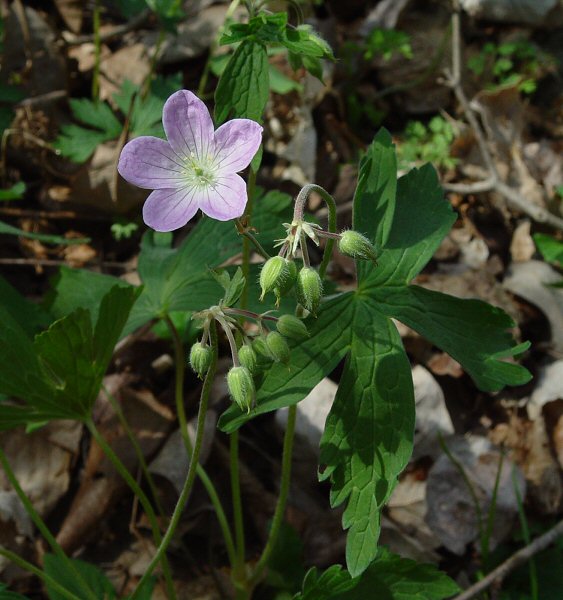Geranium maculatum L.
Wild Geranium

Native
CC = 5
CW = 3
MOC = 72
© DETenaglia
Geranium maculatum L.Wild Geranium | |
 |
Native CC = 5 CW = 3 MOC = 72 |
© DETenaglia |
|
Family - Geraniaceae Habit - Perennial forb with stout rhizomes. Stems - Ascending to erect, to 70 cm long, often multiple from base, moderately pubescent with mostly downward-pointing nonglandular hairs.
Leaves - Basal and 1 or few opposite pairs on the stems, the basal ones long-petiolate, the petioles to 30 cm, those of the stems short-petiolate. Leaf blades 4-15 cm long, wider than long, depressed-ovate to bean-shaped in outline, palmately 5-lobed, the lobes more or less obovate, mostly sharply pointed at the tip, the margins more shallowly lobed and sharply and coarsely toothed, the surfaces moderately pubescent with nonglandular hairs, those of the upper surface sometimes becoming sparse with age.
Inflorescence - Appearing as axillary or less commonly terminal, long-stalked, paired, umbels of 2-9 flowers. Each division subtended by linear bracts to 7 mm long. Individual flower stalks 10-30 mm long, 1.5-4.5 times as long as the sepals, pubescent with spreading to downward-pointing nonglandular hairs.
Flowers - Sepals 6-9 mm long, not becoming enlarged at fruiting, elliptic-ovate, tapered to a short awnlike extension 1.5-3.0 mm long at the tip, pubescent with a mixture of spreading to somewhat downward-pointing shorter nonglandular and longer glandular hairs. Petals 12-23 mm long, free, broadly obovate, rounded to very slightly notched at the tip, pink or rarely white, glabrous. Stamens 10, 5 with glandular bases. Filaments broad and ciliate-margined at base, to 6 mm long, white. Anthers 1.5 mm broad, 3 mm long, light brown. Carpels 5. Styles to 2 mm long, connate. Stigma 5-lobed.
Fruits - Erect, 5-lobed schizocarps with a long stylar column, the mericarps 25-40 mm long at maturity, the seed-containing basal portion 3.5-4.0 mm long, the lateral surfaces smooth, moderately to densely pubescent with spreading nonglandular hairs 0.2-0.6 mm long, the stylar beak with spreading to loosely ascending nonglandular hairs, the slender extension between the columnar portion and the stigmas 5-8 mm long. Seeds 2.5-3.0 mm long, the surface with a fine network of ridges and pits.
Flowering - April - June. Habitat - Bottomland and mesic forests, streambanks, shaded ledges of bluffs, ravines. Origin - Native to the U.S. Lookalikes - None. Other info. - This common woodland wildflower occurs across Missouri, and ranges throughout the eastern half of the continental U.S. and into Canada. It is easily recognized by the distinctive shapes of the palmately lobed leaves and the delicately shaded flowers. Photographs taken at the Kansas City Zoo, 4-28-00, and at Charrette Creek, MO., 4-17-04 (DETenaglia); also at Young Conservation Area, Jefferson County, MO, 5-2-2013, Washington State Park, Washington County, MO, 4-24-2017, and Busch Greenway / Duckett Creek, St. Charles County, MO, 6-4-2018 (SRTurner). |